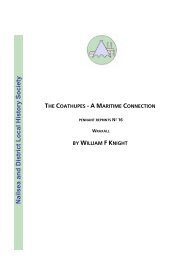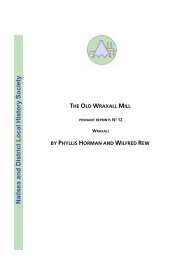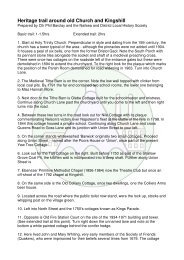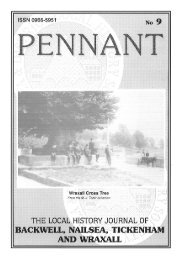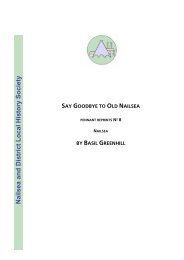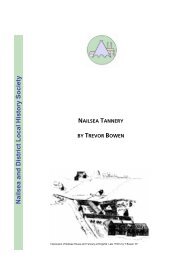No 21 - Nailsea and District Local History Society
No 21 - Nailsea and District Local History Society
No 21 - Nailsea and District Local History Society
- No tags were found...
Create successful ePaper yourself
Turn your PDF publications into a flip-book with our unique Google optimized e-Paper software.
<strong>Nailsea</strong> Coalmines "Steampower"an extract from the book by Margaret ThomasAlthough horsepower had solved efficiently the problem of power for windingin the coal mines, attempts to harness wind or water power for pumping hadlimited application in the coal mining sphere. The introduction of the firstefficient steam pumping engine by Thomas Newcomen in the early years of theeighteenth century was to transform the situation, allowing exploitation of coalmeasures previously inaccessible because of the build-up of water.The earliest surviving reference to a steam engine, in a <strong>Nailsea</strong> context, was notuntil 1747. Steam engines were then known as “fire-engines” which succinctlydescribes how they functioned. At a very basic level, the principle involved thelighting of a fire (furnace) under a large metal container (boiler) full of water,which was then heated to provide steam. The earliest were haystack boilerswhich were round, with the furnace lit directly beneath them. Later, wagonboilers, with horizontal cylinders, more efficient in their use of coal, wereintroduced at <strong>Nailsea</strong>, sometimes replacing the earlier boilers but sometimesworking side by side with them. Boilers in the <strong>Nailsea</strong> field were usually builtoutside the stone towers which housed the steam engines, hence their name,engine house.The steam was transferred to the cylinder of the steam engine, but these wereat first so badly made that they could not withst<strong>and</strong> much pressure. Therefore,steam had to be used in conjunction with atmospheric pressure to work thepiston inside the cylinder, which in turn worked the counter-balanced beam,with its pump rods down the shaft. The cooling of the steam which filled thecylinder from the boiler, created a vacuum, causing the piston’s downwardsmovement, which in turn, pulled up the pump rods, allowing water to beraised. In turn again, their weight, pulling the rods down the shaft, created theupward strike of the piston , allowing the cylinder to again fill with steam. Thesteam itself was cooled using a jet of water provided, by a self-acting valve. Theopen-topped atmospheric engine remained in use in the <strong>Nailsea</strong> field long afterthe work of James Watt pioneered vastly improved steam technology.The atmospheric engine was wasteful in that it consumed vast amounts of coal,rendering it expensive <strong>and</strong> inefficient in other areas, but in <strong>Nailsea</strong>, coal was theone commodity in plentiful supply. These engines continued in use <strong>and</strong> indeedwere specially manufactured for use in the <strong>Nailsea</strong> mines as late as the 1830s. In1838, for example, Rodgers’ Boilerworks in Bristol made a haystack boiler of



